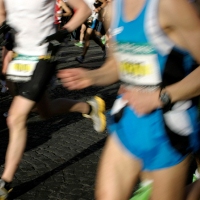 Marathon runners who are less fit or lack the proper training can impair their heart with the stress of long-distance running, new Canadian research, presented on October 25, shows.
Marathon runners who are less fit or lack the proper training can impair their heart with the stress of long-distance running, new Canadian research, presented on October 25, shows.
Good news is that injury to the cardiovascular muscles for most runners is temporary and reversible, says cardiologist Dr. Eric Larose, a professor of medicine at Laval University in Québec City.
Doing extreme endurance exercise, like training for a marathon, can damage the heart, research reveals. MRI scans on 40 athletes training for challenging sporting events like triathlons or alpine cycle races showed most had stretched heart muscles. Although many went on to make a complete recovery after a week, five showed more permanent injuries.
The researchers told the European Heart Journal how these changes might cause heart problems like arrhythmia.
They stress that their findings should not be taken to mean that endurance exercise is unhealthy.
In most athletes, a combination of sensible training and adequate recovery should cause an improvement in heart muscle function, they say. They believe more investigations are now needed, since their small study in Australia did not look at any associated health risks.
Extreme training
The Medical Director of the London Marathon, Professor Sanjay Sharma, agreed that more research was needed and said the results provided “food for thought”.
“My personal feeling is that extreme endurance exercise probably does cause damage to the heart in some athletes. I don’t believe that the human body is designed to exercise for as long as 11 hours a day, so damage to the heart is not implausible.” He said that it was too early to say that taking part in endurance sports causes long-term damage.
And Doireann Maddock of the British Heart Foundation said the findings should not put people off doing exercise. “It is important to remember that the health benefits of physical activity are well established. The highly trained athletes involved in this study were competing in long distance events and trained for more than 10 hours a week.
In the study, the scientists studied the athletes a fortnight before their races, immediately after their races and then about a week later. Immediately after the race, the athletes’ hearts had changed shape. The right ventricle – one of the four chambers in the heart involved in pumping blood around the body – appeared dilated and didn’t work as well as it had been in the weeks leading up to the race.
Levels of a chemical called BNP, made by the heart in response to excessive stretching, increased.
A week later, most of the athletes’ hearts had returned to the pre-race condition. Five athletes, who had been training and competing for longer than the others, had signs of scarring of the heart tissue and right ventricular function remained impaired, compared with the pre-race readings.

663063 979562Hi there, just became aware of your weblog via Google, and discovered that its truly informative. Ill be grateful should you continue this in future. Lots of men and women will benefit from your writing. Cheers! 999130
666435 505971Hiya! awesome blog! I happen to be a day-to-day visitor to your site (somewhat more like addict ) of this site. Just wanted to say I appreciate your blogs and am searching forward for far more to come! 249768
272506 713807Attractive section of content material. I just stumbled upon your blog and in accession capital to assert that I acquire actually enjoyed account your blog posts. Anyway I will probably be subscribing to your augment and even I achievement you access consistently quickly. 66479
463093 600174Oh my goodness! an exceptional post dude. Thank you Nevertheless Im experiencing dilemma with ur rss . Do not know why Cannot register for it. Could there be any person getting identical rss difficulty? Anybody who knows kindly respond. Thnkx 203296
349740 12084You created some decent points there. I looked on the web for the problem and discovered most individuals will go coupled with along with your internet site. 923554